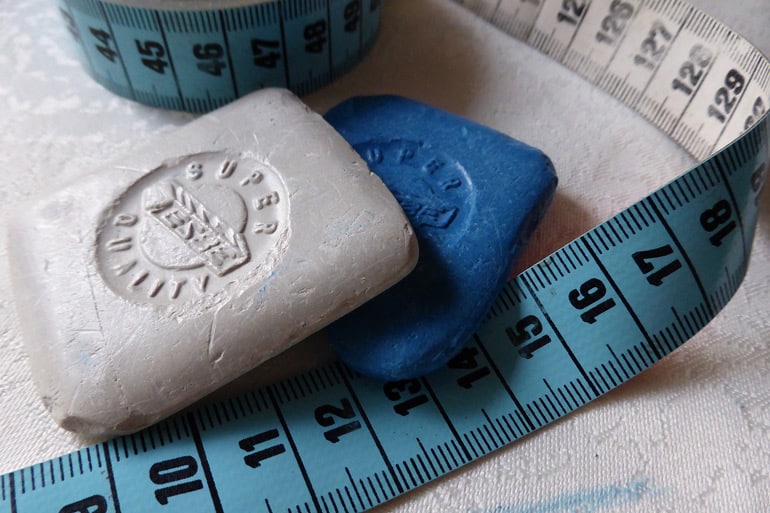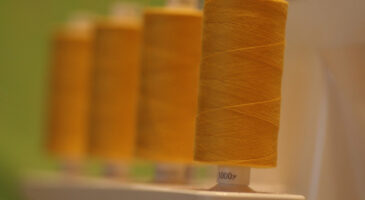You may not be a tailor or have ever tried to make clothes by yourself before, but if you have been to a tailor’s shop before, there is a great chance that you have seen a Tailor’s chalk before. It is that tiny piece of hard chalk that your Tailor was using to make markings on garments. Ring a bell?
I am sure now you have an idea of what I am trying to talk about, but there is more to understand about this mark-making sewing tool. They exist in various forms; some come in powdery form, but this type is usually accompanied by an applicator, while others may take the form of a pencil.

Seeing how the surface of fabrics is usually messed up with several marks made with this chalk while cutting, you may find yourself wondering, does Tailors’ chalk wash off? You will find answers to this question in this article, plus some bonus details about the chalk.
Does Tailors’ chalk come off?
Yes, Tailors’ chalk comes off. Of course, Tailors’ chalk designers know what they are making has the potential of causing stains, hence the reason why they are often made temporary and not permanent.
Even the waxy type that seems to be the most stubborn is designed to melt by itself into the fabric if no effort is taken towards cleaning it. Therefore, be rest assured that whenever you use Tailors’ chalk, it will clean out by itself.
What is Tailor chalk?

Simply put, Tailor chalk is a specialized type of chalk that is made specifically for making temporary marks on fabrics. Sewists and designers use this tool to make markings where they intend to cut fabrics or make alterations to garments or mark hemmings, darting lines, etc.
This chalk is invaluable to dressmakers as it is easy to use and does not leave any traces behind after application.
When was Tailor chalk invented?
Tailor chalk has been in existence for over a hundred years now. According to historical accounts, tailors started using this tool in 1880.
What is Tailors’ chalk made of?

Majorly, Tailor’s chalk is made of talc (magnesium silicate), but it also contains several other materials like 2-methoxy naphthalene 28-25 weight portions, sodium dodecyl sulfate 2-6 weight portions, calcium stearate 1-5 weight and some other secondary materials like stearic acid, Camphor, and others.
What is the difference between Tailor chalk and regular chalk?
Tailors’ chalk is not entirely different from regular chalk in the sense that they both are designed to make marks, albeit in different situations. The difference between these two chalk types is in their shape, and that Tailors’ chalks are more compressed, and that is why they do not crumble easily as regular chalk. Also, Tailors’ chalk makes the sharpest lines.
How does Tailors’ chalk work?

Tailors’ chalk works the same way as your regular chalk or pencil, just hold the chalk the usual way and mark the spot on the fabric where you intend to take the fabric in or let it out or shorten it. You can also use it to Mark the spot where you want an embellishment to be placed on the garment.
Is Tailors’ chalk washable?
Yes, Tailors’ chalk is washable. Tailors’ chalk does not leave a trace or any permanent or greasy stains on the fabric after use. Tailor’s chalk is designed in such a way that it can be easily cleaned. Even if you do not clean them, they fade by themselves.
How do you keep Tailors’ chalk sharp?
Once the sharp edges of your Tailors’ chalk start to become duller, it is straightforward to get them sharpened again, and the beauty of the whole thing is that you don’t need any special tool. You can use home-based gadgets like paper scissors, a vegetable peeler, and a kitchen knife.
To use any of these tools, just run their sharp edges along the sides and top of the Tailors’ chalk till you are satisfied that it is well-sharpened.
How do you get rid of Tailors’ chalk?
Knowing the material used in making your Tailors’ chalk can help to simplify the removal process: tailors’ chalk can be made either clay-based or wax-based.
If your Tailors’ chalk is clay-based, the best, most effective way of removing the stain or any traces left behind is by using a fabric eraser. And as for the other type (wax-based), your best bet is to apply heat so that the stain can melt.
Tips when using Tailors’ chalk
The only tip there about using Tailors’ chalk is to test the chalk on a piece of fabric before applying directly to your project. By doing this, you will be able to practice how to remove possible stains that might be left behind after application.
Can I iron over Tailors’ chalk?
Yes, you can iron over Tailors’ chalk. If your fabric needs to be ironed while there are some marks on it, you can iron over the marks.
If the Tailors’ chalk is made with wax, then doing so can help you get rid of the chalk traces once and for all. But if it is clay-based, you might have to clean the stains after ironing. What’s important to know here is that iron does not set Tailors’ chalk marks.
Is Tailor chalk toxic?
Yes, Tailor chalk is toxic. Although, in general, when you eat or swallow chalk, you may not be affected in any way, when too much of it is ingested, it can be dangerous. So it would be advisable always to make sure that this hard substance does not come in contact with your mouth.
What can I use instead of Tailor chalk?
If your Tailor chalk finishes amidst a project and you do not want to waste any time, you can make use of a bar of white soap. Obviously, this is not what the soap is designed for, but it will produce similar results. You can also use regular chalk as an alternative, but the result might be different.
References:



